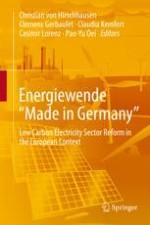2018 | OriginalPaper | Chapter
9. Sector Coupling for an Integrated Low-Carbon Energy Transformation: A Techno-Economic Introduction and Application to Germany
Author : Jens Weibezahn
Published in: Energiewende "Made in Germany"
Publisher: Springer International Publishing
Activate our intelligent search to find suitable subject content or patents.
Select sections of text to find matching patents with Artificial Intelligence. powered by
Select sections of text to find additional relevant content using AI-assisted search. powered by
